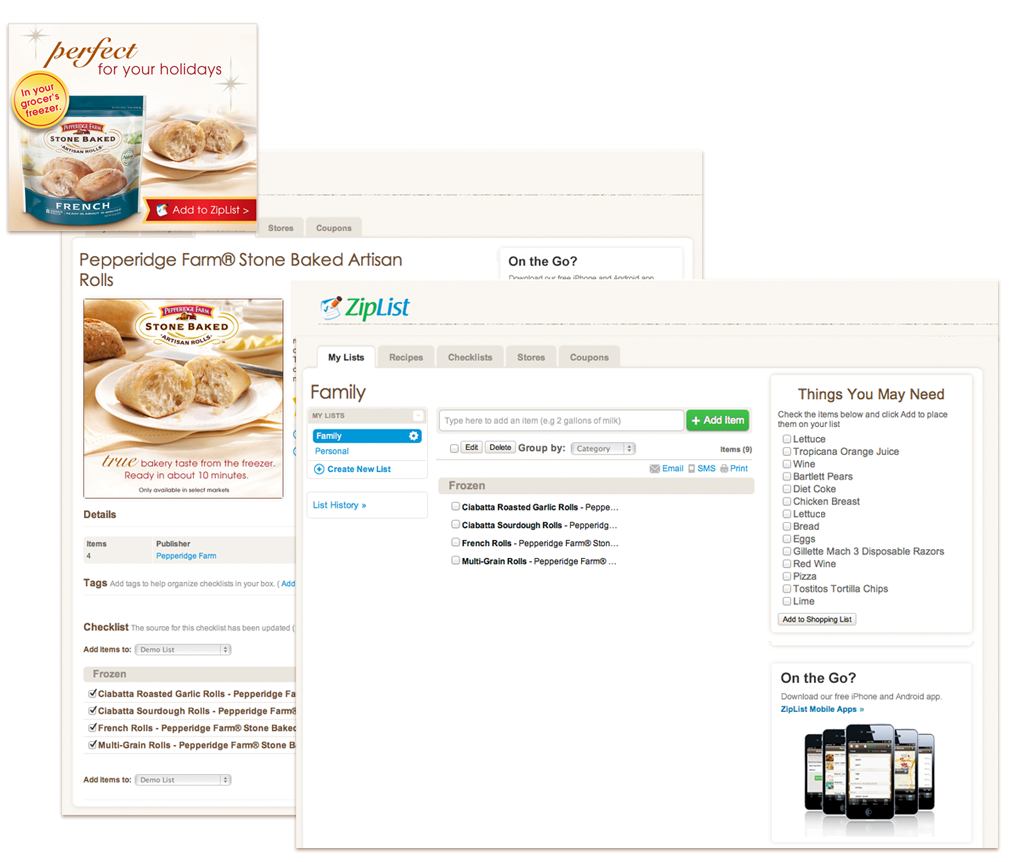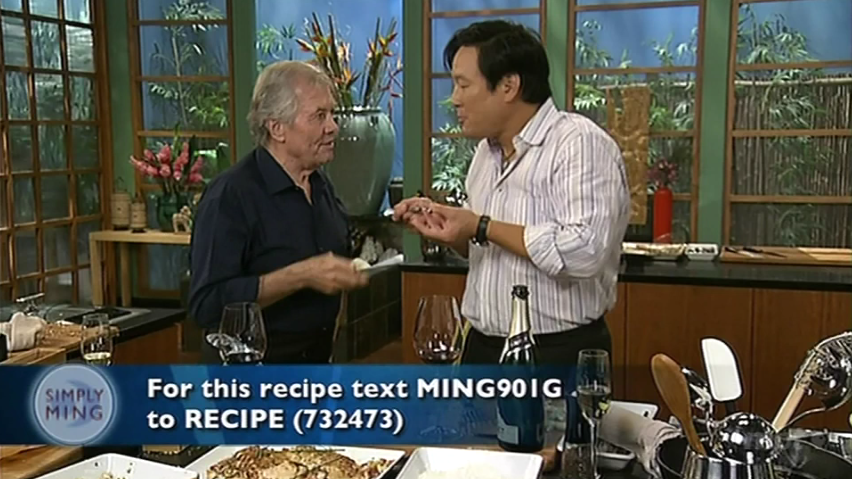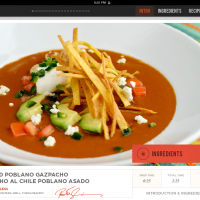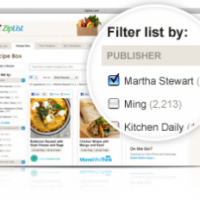Technology in the 1970s – 1990s made it easy to buy the same quality hamburger at any McDonald’s for an affordable price. Technology in the 2010s is making it easier to find recipes and buy ingredients, based on your personal preferences. Yet, it’s much easier to put a price tag on a physical product, forcing startups in this space to find new ways of monetizing information.
Grocery list and recipe search startup Ziplist is designed to do just that. The startup uses a cadre of advanced technologies to make shopping and marketing easier and personalized, including natural language processing, machine learning, artificial intelligence, and pattern recognition.
There are a number of shopping list apps on the market, however unlike most sites, Ziplist does not aspire to be a destination site. ZipList starts with the fundamental needs of their users – the ability to access recipes and shopping lists wherever they are and through a variety of platforms or mobile devices. The service can also be accessed by email and text message, making the barrier to entry low for those less technologically inclined.
For publishers, their value proposition is equally as strong. Ziplist creates new opportunities for consumer engagement, extending content relevance, accessibility, and ultimately usefulness beyond the publishers own platform. As users save recipes, Ziplist is able to provide publishers with data about the popularity of their content.
With rich cross-platform data about a users interests and purchasing intent (including historical data) Ziplist could offer a trove of helpful insights for advertisers. For bloggers, Ziplist’s WordPress recipe plugin seems to be a no brainer, as it helps them easily format their recipes in the structured hRecipe format used by Google and Bing to search for recipe content.
Ziplist is well positioned to rapidly increase user acquisition based on the accessibility of their tools across multiple platforms and devices, intuitive design, and compelling partner incentives. Profitability, however, is less certain as it is contingent on how valuable their data is to publishers and advertisers. Is information about purchasing intent and content popularity enough? Competition is steep in the Consumer Product Good advertising and market research spaces. There are also a number of startups looking to monetize their platforms through targeted coupons and deals. It will definitely be interesting to see how Ziplist fares as they begin focusing more aggressively on monetization.
Read my interview with Ziplist CEO Geoff Allen for an inside look at the secret sauce that makes Ziplist worth keeping a close eye on.
_________________________
DG: Why do grocery shopping lists and recipe management need to be innovated?
GA: The fundamental problem with existing web and mobile shopping list and recipe solutions is the degree of fragmentation and isolation. Our view is that in order for them to be useful to the point where people depend on them every day, they need to be wherever users are, via whatever method they want. Nobody maintains five shopping lists and five recipe boxes in the real world, so why would they want to maintain a different list and recipe box on every site or mobile app they use? They don’t. In order to be truly useful, people must always be able to access their list and recipe box, whether they are using ZipList products or any of our many partners’ websites or mobile apps.
DG: How does Ziplist work?
GA: ZipList is a universal platform that provides the ability for users to interact with their shopping lists, checklists and recipes from any property that is using our technologies. They can interact with ZipList via ZipList.com, ZipList’s iPhone and Android apps, partner versions of ZipList embedded on their sites, our partners’ iPhone and Android apps, via email, text messages, QR codes, our add-to-ziplist buttons (on any of the 1,800 food related web sites that have embedded our add-to-ZipList buttons), or on over 50 of the most popular recipe web sites using our Web recipe clipper bookmarklet.
Multiple lists can be created by the user, both shared and personal, and items can be added simply by typing them in natural language, by scanning barcodes, automatically adding recipe ingredients from recipes or items from checklists. It has many additional capabilities such as assigning stores to items, marking items as important, adding notes and coupon information, allowing users to organize their items by category and aisle order for each store, and much more.
DG: How do you link the actual purchase of an ingredient with recipes?
GA: Recipe ingredients are automatically added to shopping lists. We also have intelligent algorithms that recognize common pantry elements that you likely have so they are not always added to your list, which can be quite annoying. Who needs to constantly purchase ½ teaspoon of salt? We can infer when items are actually purchased with a high degree of accuracy based on a number of factors such as frequency of adding and deleting items, consistency, likely purchase windows and the user’s geographic proximity to a known grocery store when using any of our mobile apps.
DG: Could you describe how your algorithms identify purchase intent and what you do with that data?
GA: Much like how we link the likely purchase of items added to lists as discussed above, we can recognize not only natural language entries by users and classify them, but we have millions and millions of historical data points on list transactions. These list transactions come from the user manually adding items, bar code scanning and recipe ingredients and checklist items being added to lists. Our recognition and classification algorithms, which are based on artificial intelligence, machine learning, pattern recognition and the like are data mined to provide very accurate projections of future purchase intent. We use the results of this analysis to personalize the user’s experience – initially to provide enhanced recipe search results by factoring in existing recipe and shopping list behavior, as well as suggesting items you may need to purchase based on frequency and behavior of both the individual user as well as our user base as a whole. In the future we intend to use this data to provide the most relevant offers, coupons and promotions in the industry, because it is based entirely on what the user expressly purchased in the past (as well as users that are similar to them).
DG: What is your business model?
GA: Our model is around helping people buy the things they want. When somebody needs something, they put it on a list. When they want to find a recipe, they save it and add ingredients to a list. By doing this we generate additional web and mobile engagement for our partners (we also create new ad inventory with transactional value — not just page views) which gives us the ability to offer more personalized, relevant advertisements and offers to consumers. We can do this because we have a full picture of what they are purchasing across a broad variety of web and mobile properties, which is totally unique in the industry. There is no better indication of purchase intent that a user putting something on a shopping list, and the ad inventory we create by helping consumers do this is quite attractive to advertisers.
DG: How many major media partners are you working with and what does the partnership entail?
GA: We currently have over 40 partners that are live with our full solution, including major media brands, celebrity chefs and food bloggers. We have nearly the same number coming online over the next few months, with more requests coming in daily. We also have over 1,800 food blogs that are using our recipe box and shopping list plugin. Stay tuned for some additional announcements of other major national media brands as well, and not just on the web.
DG: What is your value proposition for media partners and bloggers?
GA: There has never been more inspiring recipe and food related content available than there is now. But the problem is that after the consumer is inspired to make a recipe, the providers don’t actually help them take action on it…they are kind of on their own. Even when the partner has a shopping list or recipe box, they are isolated to only their property, so they don’t get used in volume by their users. After all, how often to you sign on to a food site’s shopping list to add batteries and Tylenol to your list? We provide our media partners and bloggers with a best-in-class list and recipe box platform that is universally available to their audience, which is why it actually gets used. In addition to providing their audience with a more helpful, engaging experience, they also learn valuable information about the popularity of their content, the frequency of its use, and participate in a revenue share based on the capabilities that are powered by ZipList.
DG: You recently launched a Text-to-Recipe feature with Chef Ming Tsai. How does the feature work? What kind of usage are you seeing?
GA: One of the things that is so great about our text-to-RECIPE capability is that it is so simple. As a user is watching a food related television show that features a recipe, if they are inspired to make it, then there is an enormous amount of effort required to actually get that food on their kitchen table. The user has to remember the recipe name, go to the show’s web site, locate it, then save or print it. Moreover, if they are not a registered user of that site, they often have to go through a lengthy registration process, and remember yet another login and password. We have hard data from many media partners that there is lower than desired response from their TV shows and the abandonment rate on the registration screens is much higher than they want.
Using our Text-to-RECIPE, the TV show simply displays a graphic at the bottom of the screen saying something like Text MING901 to RECIPE (732473) to save this recipe. MING901 is a keyword (Ming Season 9, recipe 1) ,which is linked to the recipe, and we automatically create an account for the user based on their phone number (if they don’t already have an account). We return a shortened URL to their phone, which they can either click on if they have a smartphone, or visit on the web if not – which takes them to either the media provider’s version of ZipList or ZipList.com, whichever our partner prefers. If the user is not registered, they simply have to provide the an email or any popular social sign in like Facebook or Twitter to access their personal recipe box – no long, tedious registration form that is so common on most sites. And the next time they use Text-to-RECIPE, they don’t have to log in again, not only on the TV show’s site, but for any other partner using ZipList’s technology. It’s totally seamless and takes only a few seconds.
While Ming’s show has only run for a few days and in limited markets (each PBS affiliate controls when they run programs), we are excited to see it is being used. Once we have a statistically relevant period of data, we’ll be in a position to provide more specific data.
DG: What are the most interesting and/or unexpected things you’ve learned?
GA: We were absolutely stunned at the current low level of utilization of recipe boxes and shopping lists on websites and apps from major media providers, CPG brands and retailers. There are two reasons for this – their capabilities are typically not very deep, but more important they suffer from the fundamental problem ZipList was designed to solve – that their lists and recipe box exist on an island. While we assumed that was true, the data was overwhelming.
The second thing that his been quite unexpected, has been the enormous growth of our WordPress recipe plugin. It provides the simplest possible way for bloggers to format their recipes in a database-driven, structured hRecipe format – which is more important than ever now since both Google and Bing have adopted hRecipe as a major influencer to increase SEO value. Our plugin also automatically adds ZipList’s recipe box and shopping list capabilities to their blogs, which further increases the value they provide to their audience and keeps their brand in from of their users even after they exit their site. In just the last few months, we have had over 1,800 downloads, are averaging over 20 new downloads per day, and are getting multiple new partner inquiries each day requesting to embed our full ZipList shopping list and recipe box functionality on their sites.
DG: What are the greatest challenges you’ve faced?
GA: There were two real challenges. One was to build out the most sophisticated list, recipe box and checklists platform in the industry, which enables cross platform access via web, mobile web, iPhone and Android apps, partner apps, partner web sites, partner buttons, QR codes, text shortcodes, email, instant messages and email. And to do that using a single universal user account using any of the following methods: email address, site-specific user accounts, social sign on and phone numbers. And lastly, to do that both within our ZipList brand as well as fully within our partners’ brands. This was an enormous engineering effort that took over 18 months.
That all sits upon a sophisticated set of algorithms that identify the actual shopping item from natural language entries, bar code scans, recipe ingredients and checklist ingredients, which are completely unstructured. This is our secret sauce — being able to accurately identify and classify list items, which lets us provide personalized recommendations for recipes and checklists, suggest needed items on the user’s lists and ultimately provide the most relevant offers, coupons and promotions to our users based on known purchase behavior. There is no better offer to a consumer than for something we know they are interested in (and also knowing when they are interested in it).
Secondly, there was the emotional and philosophical challenge to our earliest partners to understand that they could never truly “win” with the consumer and gain strong usage and adoption of their own lists and recipe boxes, because we demonstrated that users don’t use five different lists and recipe boxes on the web. This required a thought change for them to relinquish the list to the user. Even though that was required to be successful, they had always assumed that was part of their value prop. But once they understood that they could only accomplish their goals by solving the consumer’s problem on a single place that is about them, the adoption of our platform has grown dramatically. Each new partner is now seeing the huge value of the breadth of our network, because as more sites and apps use our platform, it becomes that much more valuable both to the user and the partner alike. It is a classic network effect.









